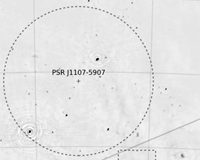'Exotic pulsar' theories confirmed with BETA
|
BETA image of the area around PSR J1107-5907, |
14 December 2015
The latest paper to be published from ASKAP has used commissioning data to confirm theoretical predictions of an ‘exotic’ intermittent pulsar almost 6,000 light years away.
The paper, A pilot ASKAP survey of radio transient events in the region around the intermittent pulsar PSR J1107-5907 [available on arXiv], demonstrates the unique capabilities offered by ASKAP, such as a wide field-of-view, the radio quiet environment of the Murchison Radio-astronomy Observatory (MRO) and the ability to conduct long-tracks on the source compared to other lower frequency (700-1000 MHz) observations.
In what was the longest observation of this pulsar to date, the team used six ASKAP antennas (installed with Mk I receivers) – the Boolardy Engineering Test Array, or BETA – to track the source over 13 hours, taking 2 minute snapshots at a time. Coincident observations were also taken with CSIRO's Parkes telescope to confirm the results.
Pulsars are usually discovered through the detection of their regular train of pulses. However, some sources – intermittent pulsars – are also known to suddenly switch off or to emit giant pulses.
PSR J1107-5907 was of particular interest to the team not only because of its ‘detectability’ with BETA, but also because of the irregularity at which it moves between off/weak/strong states, sometimes remaining ‘switched off’ for long periods of time (sometimes as long as 40 minutes) before unexpectedly emitting a giant pulse.
According to George Hobbs, lead author on the paper, the project revealed a number of advantages that ASKAP can offer to future transient search projects, such as the ASKAP Survey Science Projects VAST and COAST.
“The great thing is, because this work was done during commissioning of the first ASKAP antennas, this survey can almost be considered a ‘worst case’ example of future transient searches that we might do with the full telescope,” said George, “We were able to study PAF image quality, compare processing pipelines and searched for other Galactic sources that might be hiding nearby.”
Throughout 2015, commissioning activities with BETA have collected approximately 192 TB of data across 2000 scheduling blocks. These activities have resulted in multiple scientific publications, which demonstrate the effectiveness of the ASKAP PAFs to probe niche areas of parameter space.
A key point behind these publications is that they would not have been possible without the unique capabilities of BETA, especially the radio-quiet environment of the MRO. Not only do the commissioning activities provide a great foundation for ASKAP Early Science in 2016, they also give a glimpse in to the future of radio astronomy.
“The full ASKAP telescope will be an ideal instrument for discovering intermittent pulsars that spend a significant time in the ‘off’ state, and future transient surveys might lead to the discovery of unknown intermittent pulsars,” continues George, “Additionally, as pulsars are a key science driver for the SKA telescope, this work reinforces the types of surveys we might be able to do in the future.”
Back to Latest ASKAP News page.

 T
T